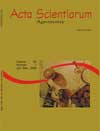<b>Genetic diversity and determination of the optimum number of RAPD markers in lettuce (<em>Lactuca sativa</em> L.)</b> - DOI: 10.4025/actasciagron.v25i1.2142
Abstract
Twenty lettuce accessions from the UENF Germplasm Collection were assessed for genetic diversity using RAPD markers. Multivariate statistical techniques were used, such as grouping analyses, using the Tocher and Single Linkage methods. Analysis of 55 polymorphic markers, obtained with 25 primers, showed that there was sufficient variability in the material studied to be exploited in future breeding programs. The ‘BGH 4060’ and ‘Grand Rapids’ accessions were the most dissimilar, while ‘BGH 4325’ and ‘BGH 4326' were the most similar. There was high agreement between ecogeographic origin and molecular similarity. It was further found by the stress statistic (Kruskal, 1964) and by the correlation between number of markers and increase in ideal formation of groups that 50 polymorphic markers is the optimum number for genetic diversity study in the assessed accessions.Downloads
Download data is not yet available.
Published
2008-04-23
How to Cite
Tardin, F. D., Amaral Júnior, A. T. do, Pereira, M. G., Vidigal, M. C. G., Daher, R. F., & Scapim, C. A. (2008). <b>Genetic diversity and determination of the optimum number of RAPD markers in lettuce (<em>Lactuca sativa</em> L.)</b> - DOI: 10.4025/actasciagron.v25i1.2142. Acta Scientiarum. Agronomy, 25(1), 1-5. https://doi.org/10.4025/actasciagron.v25i1.2142
Issue
Section
Agronomy
DECLARATION OF ORIGINALITY AND COPYRIGHTS
I Declare that current article is original and has not been submitted for publication, in part or in whole, to any other national or international journal.
The copyrights belong exclusively to the authors. Published content is licensed under Creative Commons Attribution 4.0 (CC BY 4.0) guidelines, which allows sharing (copy and distribution of the material in any medium or format) and adaptation (remix, transform, and build upon the material) for any purpose, even commercially, under the terms of attribution.
2.0
2019CiteScore
60th percentile
Powered by 

2.0
2019CiteScore
60th percentile
Powered by 



















































